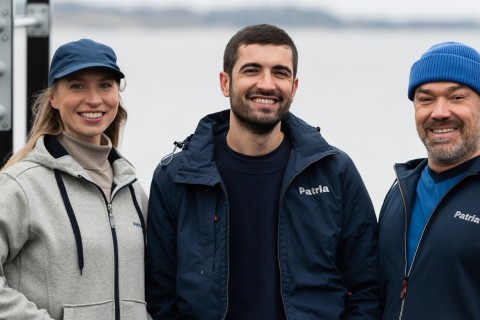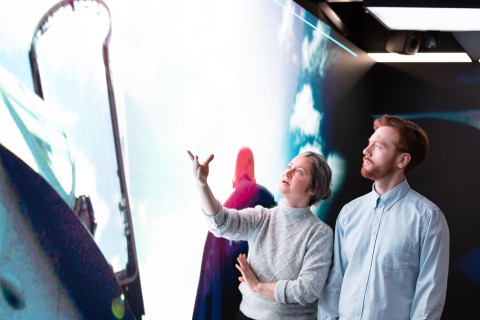
Flying start for NH90
5.12.2017
Patria landed a major contract for the heavy maintenance and repair of NH90 helicopters with the Norwegian Air Force last spring. In this case, the recipe for success was copied from life cycle support experiences in Finland and Sweden: the operation in Norway begun faster than anyone could have expected.
Text: Arild Nordahl
Photos: Gunn Schønning Jakobsen
Bardufoss in the Northern Norway locates 500 km from Rovaniemi and 130 km from Tromsø. The Norwegian Armed Forces’ main helicopter fleet in Norway is stationed in Bardufoss.
Patria’s Helicopters unit in Norway has been operating since 2011, when Patria purchased a local company, NAC Maintenance AS, which specialises in aircraft maintenance. Patria’s goal is to play a major role as a partner in Norwegian NH90 maintenance from the very beginning. The Norwegian Armed Forces’ main helicopter fleet in Norway is stationed at Bardufoss airport, where Patria’s maintenance operations have been located in two hangars rented from the Norwegian Armed Forces. There are now some 30 employees. Patria has already been working close to the customer for six years and the contract can be viewed as the result of long-term commitment. “The machines have a life span of several decades. We are here to stay and want to establish a committed partnership with the Norwegian Armed Forces,” says Jukka Holkeri, President of International Support Partnerships business unit.
Experienced start
The maintenance work got off to a flying start. Technical Manager Jari Lappalainen moved from Finland to lead the startup of NH90 maintenance at Bardufoss, bringing well-established routines and systems that were in place in just three weeks. “The startup has been easy. We were prepared for 60 days, but needed only a third of that. Only the surroundings were actually new. The work itself and the systems were already tested and well-established at Patria. The personnel are professional and, as a company, Patria has wide experience of the NH90,” says Lappalainen. Lappalainen has learned that the Norwegian and Finnish working cultures are very similar. Communication is easy and the quality of work is of the same level in both countries. “The demands of the Finnish Armed Forces are identical to those in Norway; to gain as many high-quality hours in the air as possible and to lower the flight-hour price,” he continues. Technical management is one of Lappalainen’s core competencies. He therefore has great expectations for the future, when he can plan for all of the opportunities presented by the brand-new hangar.
Building of own hangar
Dan Kjetil Nordheim and Jari Lappalainen are planning the construction of a brand-new hangar.
Country Manager Dan Kjetil Nordheim is currently examining drawings of a new 4,000 m2 hangar. The related social and canteen facilities are planned for up to 100 employees. The new hangar, which will be located right next to the runway at Bardufoss Airport, should be completed in 2019. Nordheim is a local lad who gained his first experience as a mechanic here at the hangars. He has wide experience as a manager of major international companies, having been headhunted from the Kongsberg Group, one of Patria’s two Norwegian partners. Nordheim is very happy with the company structure, which brings together Finnish and Norwegian life cycle support expertise. “The bidding process for the NH90 formed part of my duties, and I was heavily supported by other Group units located in Sweden and Finland. Six other Norwegian and international companies submitted tenders for the project. The winning factor was Patria’s outstanding competencies with respect to the NH90 helicopters. We prepared carefully and our plan came through 100 percent. Otherwise, my job here would have been very difficult,” says Nordheim.
The winning factor was Patria’s outstanding competencies with respect to the NH90 helicopters’ maintenance and overhaul.
Ambitious growth goals
The maintenance and overhaul are going as planned six months after the signing of the agreement. Three choppers are being worked on by 24 mechanics. Patria has an ambitious development goal for Bardufoss, where the Finnish company is expecting heavy growth in the number of maintained helicopters, in terms of personnel as well as the overhaul in general. This is part of the main plan, as Patria is seeking an even larger share of the maintenance market. Based on Patria’s figures for 2016, revenue and the number of employees will increase five-fold over the next five years. Development has increased faster than expected, and Patria’s goal may be achievable in just a year’s time. Nordheim strongly believes that “anything is possible, until the opposite is proven”. The service need per flight hour seems greater than expected. When all of the 14 NH90 helicopters are in operation (scheduled for 2020), the value of the maintenance agreement will further increase.
Short contract ‒ long-term strategy
The helicopters have a life span of several decades. Patria wants to establish a committed partnership with the Norwegian Armed Forces.
“Economic growth in Norway will offer many opportunities for development, as larger parts of the Norwegian oil industry move further north. The number of helicopters in the Barents Sea will increase drastically, favouring Patria’s location at Bardufoss,” Nordheim continues. Patria is also ready to provide service and maintenance for Norwegian rescue helicopters. This may result in further missions within the defence sector, as the Norwegian army phases in its helicopters. “Patria is a very solid company and we are committed to Norway,” says Dan Nordheim. For his part, Lappalainen is thinking about the brand-new hangar, with a workshop environment creating the best possible work platform for the personnel and the choppers. The entire Lappalainen family has moved to Norway and can hardly wait for the snow to settle on the mountains so that they can start skiing.
In the hangars, the mechanics are working on maintenance of three helicopters. Patria is expecting heavy growth in the number of maintained helicopters, in terms of personnel as well as the overhaul in general.
What did you like about the article?
Thank you for your opinion! You can share the article on social media using the buttons below:
These articles might also interest you
18.12.2025
Patria AMV XP - Performance evolved
12.12.2025
Patria SHIFTR - Communication wins battles


























